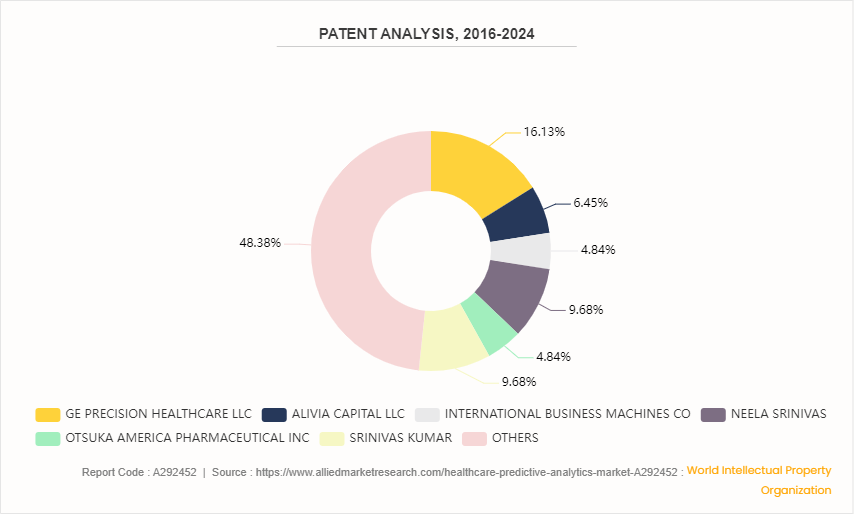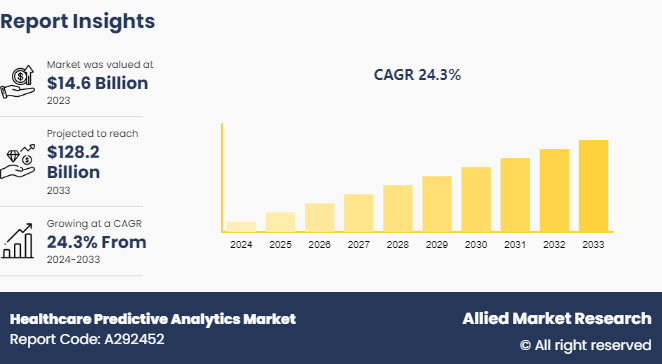Healthcare Predictive Analytics Market Research, 2033
The global healthcare predictive analytics market size was valued at $14.6 billion in 2023, and is projected to reach $128.2 billion by 2033, growing at a CAGR of 24.3% from 2024 to 2033. The global healthcare predictive analytics market is experiencing growth due to several factors such as convergence of data availability, technological advancements, regulatory imperatives, and collaborative initiatives propels the continued evolution and adoption of predictive analytics in healthcare.
Market Introduction and Definition
Predictive analytics is the process of using data to forecast future outcomes. The process uses data analysis, machine learning, artificial intelligence, and statistical models to find patterns that might predict future behavior. Healthcare practitioners can use predictive analytics to identify possibilities to make more effective and efficient clinical and operational decisions, forecast trends, and even control the spread of illnesses by analyzing historical and current healthcare data.
Despite producing vast amounts of data, the healthcare industry finds it difficult to turn that data into insights that can help patients. The goal of using data analytics in healthcare is to improve patient care and operational efficiency across the board. In addition to many other applications, it is used to research methods to lower treatment costs, forecast disease outbreaks, and enhance patient care. Analytics may assist healthcare organizations in streamlining internal operations, optimizing resource utilization, and enhancing the coordination and efficiency of care teams on a business level.
Key Takeaways
- The healthcare predictive analytics market study covers 20 countries. The research includes a segment analysis of each country in terms of value ($Million) for the projected period 2024-2033.
- More than 1, 500 product literatures, industry releases, annual reports, and other such documents of major healthcare predictive analytics industry participants along with authentic industry journals, trade associations' releases, and government websites have been reviewed for generating high-value industry insights.
- The study integrated high-quality data, professional opinions and analysis, and critical independent perspectives. The research approach is intended to provide a balanced view of global markets and to assist stakeholders in making educated decisions in order to achieve their most ambitious growth objectives.
Key Market Dynamics
The healthcare predictive analytics market size is experiencing a surge driven by numerous factors. One of the primary drivers is the increasing adoption of electronic health records (EHRs) and digital healthcare systems. These systems generate vast amounts of data, ranging from patient demographics to clinical histories, thereby driving the healthcare predictive analytics market growth. For instance, predictive models can analyze patient data to forecast disease progression, enabling healthcare providers to intervene proactively and improve patient outcomes. Moreover, the growing demand for personalized medicine and value-based care models is propelling the uptake of predictive analytics solutions. These tools empower clinicians to customize treatments based on individual patient characteristics, leading to more effective and efficient care delivery.
However, one significant challenge is data privacy and security concerns, which restraints the growth during healthcare predictive analytics market forecast. Healthcare data is highly sensitive and subject to stringent regulatory requirements such as HIPAA in the U.S. Ensuring compliance while harnessing the full potential of predictive analytics poses a considerable hurdle for healthcare organizations. Moreover, data interoperability issues hinder the seamless integration of disparate data sources, limiting the accuracy and reliability of predictive models. Without robust data governance frameworks and interoperable systems, the efficacy of predictive analytics in healthcare remains constrained.
On the other hand, the proliferation of wearable devices and remote patient monitoring technologies offers a wealth of real-time data streams for predictive analytics applications. By leveraging data from wearable sensors, healthcare providers can detect early signs of deterioration and intervene preemptively, reducing hospital readmissions and healthcare costs. Additionally, advancements in artificial intelligence (AI) and machine learning (ML) are unlocking new possibilities for predictive analytics, enabling more sophisticated models that can forecast complex healthcare outcomes with greater precision. Furthermore, the shift toward value-based care models incentivizes healthcare organizations to invest in predictive analytics solutions that enhance population health management and risk stratification, ultimately driving better patient outcomes and financial sustainability. As such, the healthcare predictive analytics market stands poised for continued growth and innovation, propelled by evolving technology landscapes and evolving healthcare paradigms.
Market Segmentation
The healthcare predictive analytics market is segmented into application, component, end-user and region. On the basis of application, the market is bifurcated into clinical analytics, financial analytics, operational analytics and others. On the basis of component, the market is bifurcated into hardware and software. By end user, the market is divided into payers, providers, and others. Region wise, the market is analyzed across North America, Europe, Asia-Pacific, and LAMEA.
Regional/Country Market Outlook
North America accounted for a major healthcare predictive analytics market share owing to increasing adoption of electronic health records (EHRs) and other healthcare IT systems facilitates the collection and analysis of vast amounts of patient data, enabling predictive analytics. Additionally, the rising prevalence of chronic diseases and the need for effective management of patient outcomes fuel the demand for predictive tools.
- In June 2020, Cleveland Clinic researchers set out to achieve a similar endeavor. The group developed a predictive analytics model to determine an individual patient’s likelihood of testing positive for COVID-19, as well as their potential outcomes from the disease.
- In March 2020, the UK’s National Health Service (NHS) partnered with Microsoft, Amazon Web Services, Google, Faculty and Palantir to build a digital platform based on big data, AI and cloud computing technology.
- In March 2020, The Center for Systems Science and Engineering (CSSE) at Johns Hopkins University has developed an interactive, web-based dashboard that tracks real-time data on confirmed coronavirus cases, deaths, and recoveries for all affected countries.
Industry Trends
- In February 2020, the Chinese government in collaboration with Alipay, a private online payment platform, has also created a smartphone app which gives color codes to the citizens based on the contagion risk, to help authorities track the people’s movement.
- In February 2020, GeTui, a smart data provider, has studied the number of people traveling from Wuhan, the hardest-hit city of the epidemic outbreak in central China, and released their distribution density in a heat map.
- In December 2019, BlueDot, a Toronto-based infectious disease surveillance company, had alerted its clients of a cluster of unusual pneumonia cases in Wuhan. With expertise in infectious diseases, big data analytics and digital technologies, this company found patterns across news reports that indicated the possible outbreak of infectious disease.
Patent Analysis, By Country, 2016-2024
In the global healthcare predictive analytics, GE precision healthcare LLC dominates with 11.3% of healthcare predictive analytics market share for patents, showcasing their strong innovation focus. Neela Srinivas And Srinivas Kumar follow with 9.7% and 9.7% respectively, indicating their significant presence in the market. Other key players like EMBECTA CO, BD, GE Company, Manuel Vegas Santiago, Andras Kerekes, Andras Lanczky, Bence Lantos, Elodie Weber, Erazmus Gerencser, Eszter Csernai, Travis Frosch, Alivia Capital LLC, Ge Prec Healthcare LLC, International Business Machines Co, Otsuka America Pharmaceutical Inc also contribute to the innovation landscape. These companies drive innovation in healthcare predictive analytics, offering diverse products to meet the needs to make more effective and efficient clinical and operational decisions.

Competitive Landscape
The major players operating in the healthcare predictive analytics industry include IBM, Cerner Corp., Verisk Analytics, Inc., McKesson Corp., SAS Institute, Oracle, Allscripts, Cotiviti, Inc., Citius Tech Inc, and Optum, Inc. Other players in healthcare predictive analytics market includes ExlServices Holdings, Evidation Health, MedeAnalytics, Inc and so on.
Recent Key Strategies and Developments
- In February 2024, Mount Sinai’s dedicated team of researchers were granted $4.1 million by the National Heart, Lung, and Blood Institute (NHLBI) at the esteemed National Institutes of Health (NIH) to pioneer artificial intelligence (AI) models aimed at forecasting adverse outcomes in patients grappling with obstructive sleep apnea.
- In October 2023, Health Data Analytics Institute (HDAI) , an artificial intelligence (AI) company focused on empowering clinicians, optimizing care pathways, and improving patient outcomes announces $31 million funding round to scale predictive risk platform.
- In July 2022, Trilliant Health launches an analytics tool to benchmark healthcare companies against similar markets. These benchmarks can guide an organization's strategies for new specialties and services lines, M&A activity, and expansion into new markets.
- In September 2021, Healthcare analytics company Trilliant Health developed a new predictive analytics tool that enables strategy teams to see a 10-year view of the healthcare market with insights all the way down to the local market level.
Key Benefits For Stakeholders
- This report provides a quantitative analysis of the market segments, current trends, estimations, and dynamics of the healthcare predictive analytics market analysis from 2024 to 2033 to identify the prevailing healthcare predictive analytics market opportunity.
- The market research is offered along with information related to key drivers, restraints, and opportunities.
- Porter's five forces analysis highlights the potency of buyers and suppliers to enable stakeholders make profit-oriented business decisions and strengthen their supplier-buyer network.
- In-depth analysis of the healthcare predictive analytics market segmentation assists to determine the prevailing market opportunities.
- Major countries in each region are mapped according to their revenue contribution to the global market.
- Market player positioning facilitates benchmarking and provides a clear understanding of the present position of the market players.
- The report includes the analysis of the regional as well as global healthcare predictive analytics market trends, key players, market segments, application areas, and market growth strategies.
Key Sources Referred
- EO Intelligence
- WIPO - World Intellectual Property Organization
- Centers for Disease Control and Prevention
- World Health Organization
- American Medical Informatics Association (AMIA)
- Becker's Health IT & CIO Report
- Journal of Medical Internet Research
- HealthIT.gov
- HIMSS (Healthcare Information and Management Systems Society)
Healthcare Predictive Analytics Market Report Highlights
| Aspects | Details |
| Market Size By 2033 | USD 128.2 Billion |
| Growth Rate | CAGR of 24.3% |
| Forecast period | 2024 - 2033 |
| Report Pages | 260 |
| By Application |
|
| By Component |
|
| By End-User |
|
| By Region |
|
| Key Market Players | SAS Institute Inc, Cotiviti, Inc.,, McKesson Corporation., Oracle Corp, Optum, Inc., Allscripts, IBM, Citius Tech Inc., Verisk Analytics, Inc., Cerner Corporation |
Loading Table Of Content...




